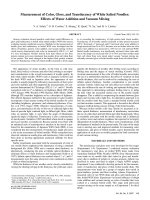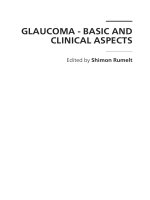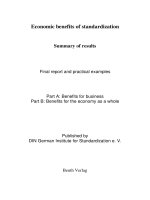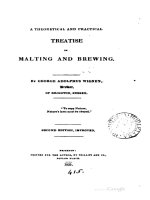POLYCRYSTALLINE MATERIALS – THEORETICAL AND PRACTICAL ASPECTS pdf
Bạn đang xem bản rút gọn của tài liệu. Xem và tải ngay bản đầy đủ của tài liệu tại đây (27.91 MB, 176 trang )
POLYCRYSTALLINE
MATERIALS – THEORETICAL
AND PRACTICAL ASPECTS
Edited by Zachary Todorov Zachariev
Polycrystalline Materials – Theoretical and Practical Aspects
Edited by Zachary Todorov Zachariev
Published by InTech
Janeza Trdine 9, 51000 Rijeka, Croatia
Copyright © 2011 InTech
All chapters are Open Access distributed under the Creative Commons Attribution 3.0
license, which allows users to download, copy and build upon published articles even for
commercial purposes, as long as the author and publisher are properly credited, which
ensures maximum dissemination and a wider impact of our publications. After this work
has been published by InTech, authors have the right to republish it, in whole or part, in
any publication of which they are the author, and to make other personal use of the
work. Any republication, referencing or personal use of the work must explicitly identify
the original source.
As for readers, this license allows users to download, copy and build upon published
chapters even for commercial purposes, as long as the author and publisher are properly
credited, which ensures maximum dissemination and a wider impact of our publications.
Notice
Statements and opinions expressed in the chapters are these of the individual contributors
and not necessarily those of the editors or publisher. No responsibility is accepted for the
accuracy of information contained in the published chapters. The publisher assumes no
responsibility for any damage or injury to persons or property arising out of the use of any
materials, instructions, methods or ideas contained in the book.
Publishing Process Manager Adriana Pecar
Technical Editor Teodora Smiljanic
Cover Designer InTech Design Team
First published January, 2012
Printed in Croatia
A free online edition of this book is available at www.intechopen.com
Additional hard copies can be obtained from
Polycrystalline Materials – Theoretical and Practical Aspects,
Edited by Zachary Todorov Zachariev
p. cm.
ISBN 978-953-307-934-9
free online editions of InTech
Books and Journals can be found at
www.intechopen.com
Contents
Preface VII
Part 1 Plastic Deformation, Strength and Grain –
Scale Approaches to Polycrystals 1
Chapter 1 Scale Bridging Modeling of Plastic
Deformation Autor and Damage Initiation in Polycrystals 3
Anxin Ma and Alexander Hartmaier
Chapter 2 Strength of a Polycrystalline Material 27
P.V. Galptshyan
Chapter 3 Grain-Scale Modeling
Approaches for Polycrystalline Aggregates 49
Igor Simonovski and Leon Cizelj
Part 2 Methods of Synthesis, Structural Properties Characterization
and Applications of Some Polycrystalline Materials 75
Chapter 4 NASICON Materials: Structure and Electrical Properties 77
Lakshmi Vijayan and G. Govindaraj
Chapter 5 Structural Characterization of New Perovskites 107
Antonio Diego Lozano-Gorrín
Chapter 6 Controlled Crystallization of Isotactic Polypropylene
Based on / Compounded Nucleating Agents:
From Theory to Practice 125
Zhong Xin and Yaoqi Shi
Chapter 7 Influence of Irradiation on
Mechanical Properties of Materials 141
V.V. Krasil’nikov and S.E. Savotchenko
Preface
Polycrystalline structures are conglomerates of a large number of crystals irregularly
situated, yet bound to each other strongly enough to behave as a whole. As the size and
the shape of these crystals are irregular too, the latter are called grains or crystallites. The
boundary surfaces connecting the grains have crystal structures that are not identical to
those of the adjacent crystallites. They are distortions, which allow a smooth transition
between the structures within the grains in contact. The mosaic of these borderline
regions represents an extended block of two dimensional imperfections.
A mechanical loading of these materials leads to deformations. With small loadings,
the deformation is elastic, slip and elastic (Young’s) modulus being its characteristics.
The Young’s modulus is an important parameter of the polycrystal materials
determining its resistance to deformation.
For higher loadings, the deformation becomes plastic. Theoretical studies,
experimental data, as well as practical observations show that this type of
deformation involves slippage in the material and active participation of its two-
dimensional imperfections. With lower temperatures (less than 0.4 T
m for metals and
0.6 T
m for alloys, Tm denoting the melting point) slippage does not occur uniformly,
but remains confined to smaller regions, which appear successively. At higher
temperatures, the critical break tension drops down. Thus, smaller loadings prove
sufficient to bring about deformation effects, such as dislocations slip, twinning,
sliding of grain boundaries, etc.
Stress level, stress rate, and temperature are the parameters characterizing the plastic
deformation of polycrystalline materials.
In these materials, the macroscopic value of their parameters is a mean value, resulting
from taking the average over domains comprising a considerable number of grains
with usually different orientations. In this way, they turn out isotropic as compared to
the monocrystals, in which sharp anisotropy is observed. In special cases, the
orientations of the grains show more or less preferred directions, leading to
anisotropy. To the best of my knowledge, one of them – polycrystalline tungsten, is
dealt with for the first time in specialized literature by Dr. P. V. Galptshyan in the
chapter: ”Strength of Polycrystalline Materials”.
VIII Preface
The book “Polycrystalline Materials” presents theoretical and practical investigations
of some polycrystals materials.
Section I “Plastic Deformation, Strength and Grain-Scale Approaches to Polycrystals”
comprises the following three chapters:
“Scale-Bridging Modelling of Plastic Deformation and Damage Initiation in Polycrystals” by
Dr. Anxin Ma and Prof. Alexander Hartmaier.
This chapter reviews the current state of modelling the phenomenon of plastic
deformation in its various aspects. The authors’ analysis involves the macro-, meso-,
micro-, and atomic scales using the finite element method, representative volume
element approaches, the dislocation dynamics method, and molecular dynamics
simulation. Steels have been used to generate realistic microstructures for all
multiphase polycrystalline materials studied. Possible approaches in order to bridge
the different length scales have been discussed and successful multiscale modelling
applications reported. On the basis of recent constitutive models provided by
continuum mechanics, the authors have elaborated a number of numerical procedures
aiming at the integration of results obtained for several length scales. In this way, they
were able to build representative volume element (RVE) models for the mechanical
behavior of materials, which are heterogeneous, with respect to the nature of grains
and phases they are made of. Once a RVE for a given microstructure is constructed
and the critical deformation and damage mechanisms are included into the
constitutive relations, this RVE can be applied to calculate stress-strain curves and
other mechanical data. The advantage of this approach is that the effects of grain size
and strength of the grain boundaries on the macroscopic mechanical response of a
material can be predicted.
“Strength of a Polycrystalline Material” by Prof. P. A.Galptshyan
It is shown that due to the greater concentration of stresses in it, the polycrystalline
material has a strength less than that of a monocrystal made of the same substance.
Hence, in order to enhance its strength, one has to reduce the stresses in the material.
A remarkable case is polycrystalline tungsten, whose elastic anisotropy factor proves
zero. This kind of tungsten is known to be a most durable substance, more so than the
tungsten monocrystals and even the diamond. For example, the ultimate strength
under tension of unanealed wires of polycrystalline tungsten is in the range of 1800
MPa to 4150 Mpa, depending on the diameter of the wire. For diamond monocrystals,
it equals 1800 MPa at 20
0
C. It is worth noting that a correspondence has been found
for polycrystalline metals between their ultimate strength and their modulus of
elasticity: the two parameters are changing in the same direction.
“Grain-Scale Modelling Approaches for Polycrystalline Aggregates” by Dr. I. Simonovski
and Dr. I. Cizelj
It has been shown that polycrystalline aggregates their microstructure, which plays an
important role in the evolution of stresses and strains, and in the development of
Preface IX
damage processes, such as small cracks in the microstructure and fatigue. Damage
initialization and evolution are directly influenced by the locally anisotropic behavior
of the microstructure, as determined by the combination of random grain shapes and
sizes, different crystallographic orientations, inclusions, voids, and other
microstructural features. For the bulk of a grain, constitutive models assuming pure
anisotropic elasticity, as well as anisotropic elasticity in combination with crystal
plasticity have been used. Analytical models for grain geometry, in view of calculating
the properties of crystalline aggregates, involve 2D and 3D Voronoi tesselations,
whereas the method of X-ray diffraction contrast tomography was utilized to measure
these properties and make a 3D characterization of the grains.
Several cases of 3D Voronoi tesselations, and two cases of stainless steel wire have
been treated. Grain boundaries were explicitly modeled, using the cohesive zone
approach, with finite elements of zero physical thickness. Initialization and early
development of grain boundary damage, with respect to stainless steel, were traced
numerically for several constitutive laws. Differences obtained in the results are small
when the approach of anisotropic elasticity is compared to combining the latter with
crystal plasticity, except for the computation time required- more than two times
longer for the second approach.
Section II “Methods of Synthesis, Structural Properties Characterization, and
Applications of Some Polycrystalline Materials” includes the following four
chapters:
“Nanocrystalline NASICON Materials - Structure and Electrical Properties” by Dr.
Lakshmi Vijayan and Prof. G. Govindaraj.
The chapter deals with an important class of solid electrolytes – sodium (NA) super
(S)-ionic (I) conductors (CON): A
x By (PO4 )3 , where A denotes an alkali metal ion and
B denotes a multivalent metal ion. They are widely tested in energy applications, e.g.
electric vehicles, and having the advantage of high ionic conductivity together with
the stability of the phosphate units. The authors have investigated the correlation
between ionic conduction and phase symmetry for a family of NASICONs, comprising
LiTi
2(PO4)3 and
A3M2(PO4)3 where A = Li, Na and M = Cr, Fe) . Structural
characterization was obtained by spectroscopic and diffraction techniques, while
mobile ions characterization proceeded through impedance spectra. Application of the
materials studied
has been discussed as well.
“Structural Characterization of New Perovskites” by Dr. A. D. Lozano – Gorrin.
The author discusses some general features of the perovskite-type materials, including
relatively new methods of their preparation (solution combustion, sonochemical
procedures, microwave assisted synthesis) as well as characterization of their structure
and physical properties by a variety of diffraction techniques (X-rays-, electron- and
neutron diffraction).
X Preface
“Controlled Crystallization of Isotactic Polypropylene Based on Alpha/Beta Compounded
Nucleating agents - From Theory to Practice” by Prof. Zhong Xin and Dr.Yaoqi Shi.
Isotactic polypropylene (iPP), one of the most important thermoplastic polymers,
exhibits very interesting polymorphic behavior. Its different crystalline forms have
different optical and mechanical properties. In this respect, alpha/beta compounded
nucleating agents for polypropylene attract more and more attention.
Three kinds of well studied alpha/beta compounded NAs (phosphate/amide,
sorbitol/amide, and phosphate/carboxylate) have been reviewed by discussing their
influence on the crystallization kinetics, crystallization morphologies, and mechanical
properties of iPP. The results show that these three NAs are able to not only increase
the crystallization temperature of iPP, but also to shorten its crystallization half-time.
Consequently, they are able to considerably reduce the molding cycle time. It has also
been found that the type of nucleation of the polymer could be changed, while the
geometry of its crystal growth remains the same.
“Influence of Irradiation on Mechanical Properties of Materials” by Prof. V. I. Krasilnikov.
This chapter discusses substantial changes in the mechanical properties of materials,
radiation embrittlement, and hardening being two of its most common and important
effects. Both of them depend on the temperature of the irradiated material.
The author has proposed a model, based on the interaction of vacancies with
interstitial barriers in order, to explain and investigate the saturation of the
dependence of yield strength on radiation dosage. In the framework of this model,
equations describing the evolution of barrier densities, as well as yield strength have
been obtained in analytical form. It has been shown that with increasing the intensity
of the barrier recombination processes, the yield strength of the irradiated material
decreases, the dependence being nonlinear. In the case of radiation hardening, the
model proves valid for both low and large doses.
Another model quantitively describing the dependence of the yield strength of
irradiated materials on their temperature has also been introduced and applied. The
results show its usefulness in dealing with the processes of plastic deformation under
irradiation. Some implications about materials used in the construction of nuclear
reactors have been discussed.
The research has been carried out to increase the lifetime of III and IV generation
reactors and practical ITER-materials.
Prof. D.Sc.Eng. Zachari Zachariev
Institute of Polymers
Bulgarian Academy of Sciences, Sofia
Bulgaria
Part 1
Plastic Deformation, Strength and Grain –
Scale Approaches to Polycrystals
0
Scale Bridging Modeling of Plastic Deformation
and Damage Initiation in Polycrystals
Anxin Ma and Alexander Hartmaier
Interdisciplinary Centre for Advanced Materials Simulation, Ruhr-University Bochum
Germany
1. Introduction
Plastic deformation of polycrystalline materials includes dislocation slip, twinning, grain
boundary sliding and eigenstrain produced by phase transformations and diffusion. These
mechanisms are often alternative and competing in different loading conditions described by
stress level, strain rate and temperature. Modelling of plasticity in polycrystalline materials
has a clear multiscale character, such that plastic deformation has been widely studied on
the macro-scale by the finite element methods, on the meso-scale by representative volume
element approaches, on the micro-scale by dislocation dynamics methods and on the atomic
scale by molecular dynamics simulations. Advancement and further improvement of the
reliability of macro-scale constitutive models is expected to originate from developments at
microstructural or even smaller length scales by transfering the observed mechanisms to the
macro-scale in a suited manner. Currently efficient modelling tools have been developed
for different length scales and there still exists a challenge in passing relevant information
between models on different scales. This chapter aims at overviewing the current stage
of modelling tools at different length scales, discussing the possible approaches to bridge
different length scales, and reporting successful multiscale modelling applications.
Fig. 1. Multiphase polycrystalline RVE (right) with 90% matrix and 10% precipitate. The
grain size has a normal distribution (middle) and the
[111] polfigure (left) shows a random
texture.
1
2 Will-be-set-by-IN-TECH
2. Generating realistic material microstructures
The current advanced high strength steels (AHSS) such as dual phase steels, transformation
induced plasticity (TRIP) steels, twin induced plasticity (TWIP) steels and martensitic
steels are all multiphase polycrystalline materials. In order to model the the macroscopic
mechanical properties such as yield stress, work hardening rate and elongation to fracture,
one has to build a representative volume element (RVE) for each macroscale material point
and investigate the local deformation of each material point within the RVE, and then
make a volume average. In this micro-macro-transition procedure, in order to reduce the
computational costs the statistically similar representative volume elements (SSRVEs) have
been developed to replace real microstructures from metallurgical images by Schröder et al.
(2010).
Considering the real microstructure of multiphase materials, during the representative
volume element generation one should consider grain shape distribution, crystalline
orientation distribution, grain boundary misorientation angle distribution and volume
fraction of different phases. Figure 1 is an example of the RVE we have generated for TRIP
steels where the Voronoi tessellation algorithm has been used.
Recent studies (Lu et al., 2009; 2004) show bulk specimens comprising nanometer sized
grains with embedded lamella with coherent, thermal and mechanical stable twin boundaries
exhibiting high strength and considerable ductility at the same time. These materials
have higher loading rate sensitivity, better tolerance to fatigue crack initiation, and greater
resistance to deformation. Under this condition, the RVE with nanometer sized twin lamella
inside nanometer sized twin lamella inside nanometer sized grains will help us to understand
existing material behavior and design new materials.
Assume two orientations Q
I
and Q
II
have the twin relationship in (1, 1, 1) habit plane along
[1, 1, −2] twinning direction. For any vector V, these two tensors will map as v
I
= Q
I
V
and v
II
= Q
II
V. The twin relationship between v
I
and v
II
is easier to see in the local twin
coordinate system with x
//[1, 1, −2] and z
//[1, 1, 1] rather than in the global coordinate
system
[
x, y, z
]
. We define a orthogonal tensor R
L
for the mapping from global coordinate
system to the local coordinate system
R
Lij
=
⎡
⎢
⎢
⎣
1
√
6
1
√
2
1
√
3
1
√
6
−1
√
2
1
√
3
−2
√
6
0
1
√
3
⎤
⎥
⎥
⎦
(1)
and another tensor R
M
for the mirror symmetry operation
R
Mij
=
⎡
⎣
10 0
01 0
00
−1
⎤
⎦
(2)
and get the twin relationship in the local twin coordinate system
R
L
Q
I
R
T
L
v
= R
M
R
L
Q
II
R
T
L
v
. (3)
4
Polycrystalline Materials – Theoretical and Practical Aspects
Scale Bridging Modeling of Plastic Deformation and Damage Initiation in Polycrystals 3
Because v
is a arbitrary vector in the
[
x
, y
, z
]
coordinate system equation 3 will reduce to
R
L
Q
I
R
T
L
= R
M
R
L
Q
II
R
T
L
(4)
and we find the relationship between Q
I
and Q
II
as
Q
II
= R
T
L
R
-1
M
R
L
Q
I
. (5)
The crystal orientation Q
I
has been assigned to the material point at the centre of the
individual grain with coordinate
x
0
, y
0
, z
0
. The orientation Q
II
will be assigned to the
twinned material point with coordinate
x
1
, y
1
, z
1
when the distance between this point and
the grain center along the habit plane normal direction and the lamella thickness d satisfy
(2k −1) −
1
2
·d <
z
1
−z
0
≤
2k
−
1
2
·d with k = 1, 2, 3, (6)
Otherwise orientation Q
I
will be assigned to this material point.
Fig. 2. The multiplicative decomposition of the deformation gradient where the plastic
deformation is accommodated by dislocation slip.
3. Constitutive models based on continuum mechanics
3.1 Kinematics
For large strains the elastic and plastic deformation can be separated consistently. We follow
the well-known multiplicative decomposition proposed by Lee (1969) (see Figure 2) of the
deformation gradient tensor F
F
=
∂x
∂X
=
∂x
∂
x
∂
x
∂X
= F
e
F
p
(7)
where F
e
is the elastic part comprising the stretch and rotation of the lattice, and F
p
corresponds to the plastic deformation. The lattice rotation R
e
and stretch U
e
are included
in the mapping F
e
. They can be calculated by the polar decomposition F
e
= R
e
U
e
, i.e., the
texture evolution is included in this part of the deformation. Furthermore, two rate equations
can be derived for the elastic and the plastic deformation gradients as
˙
F
e
= LF
e
−F
e
L
p
(8)
˙
F
p
= L
p
F
p
(9)
5
Scale Bridging Modeling of Plastic Deformation and Damage Initiation in Polycrystals
4 Will-be-set-by-IN-TECH
where L =
˙
FF
−1
and L
p
=
˙
F
p
F
−1
p
are the total and the plastic velocity gradients defined in
the current and the unloaded configuration respectively. Because the stress produced by the
elastic deformation can supply driving forces for dislocation slip, twinning formation and
phase transformation which can accommodate the plastic deformation, F
e
and F
p
are not
independent. If the total deformation process is known, the elastic and plastic deformation
evolutions can be determined through solving equations 7,8 and 9.
When the eigen-deformation F
t
of phase transformation and the plastic deformation F
p
of
dislocation slip coexist, the multiply decomposition (see Figure 3) should be reformulated as
the following
F
=
∂x
∂
x
∂
x
∂
x
∂
x
∂X
= F
e
F
t
F
p
. (10)
The evolution of F
t
is controlled by the transformed volume fraction f
α
because the
eigen-deformation
H
α
t
of each transformation system with unit volume fraction is a constant
tensor
F
t
= I +
N
T
∑
α=1
f
α
H
α
t
(11)
˙
F
t
=
N
T
∑
α=1
˙
f
α
H
α
t
. (12)
where N
T
is the total number of transformation system.
Fig. 3. The multiplicative decomposition of the deformation gradient when dislocation slip
and phase transformation coexist.
3.2 The elastic deformation
For the dislocation slip case, the plastic deformation F
p
will not change the lattice orientation,
i.e., we can use a constant stiffness tensor
K
0
for the stress calculations and define the elastic
law in the unloaded configuration. By defining the second Piola-Kirchhoff stress tensor
S in
the unloaded configuration and its work conjugated elastic Green strain tensor
˜
E, the elastic
law is derived as
S
=
K
0
E (13)
with
E
=
1
2
F
T
e
F
e
−I
(14)
where I is the second order unity tensor. When the variational principle of the FEM is
formulated in the reference or current configuration, the second Piola-Kirchhoff stress S or
6
Polycrystalline Materials – Theoretical and Practical Aspects
Scale Bridging Modeling of Plastic Deformation and Damage Initiation in Polycrystals 5
the Cauchy stress σ amount to
S
= F
−1
p
SF
−T
p
(15)
σ
=
1
J
F
e
SF
T
e
(16)
where J
= det(F)=det(F
e
), which means the isochoric plastic deformation is assumed, i.e.,
the volume change is always purely elastic.
In a polycrystal the different grains have different initial orientations. Therefore, in the global
coordinate system, different stiffness tensors, slip plane normals and slip directions should be
specified for every crystal. In order to use only one set of data, a virtual deformation step is
introduced before the calculation in the following form: F
p0
is set as the initial value for F
p
.
By choosing F
e0
to satisfy
F
e0
F
p0
= I, F
e0
, F
p0
∈ Ort h. (17)
the starting value for F amounts to I as desired. If one adopts the Bunge Euler angle
(ϕ
1
, Φ, ϕ
2
)
to define the crystal orientation, the matrix of the elastic deformation gradient amounts to
F
e0
=
⎡
⎣
cos
(ϕ
2
) −sin(ϕ
2
) 0
sin
(ϕ
2
) cos(ϕ
2
) 0
001
⎤
⎦
⎡
⎣
10 0
0 cos(Φ) −sin(Φ)
0 sin(Φ ) cos(Φ)
⎤
⎦
⎡
⎣
cos
(ϕ
1
) −sin(ϕ
1
) 0
sin
(ϕ
1
) cos(ϕ
1
) 0
001
⎤
⎦
.
3.3 The dislocation slip based plastic deformation
The plastic deformation mechanism discussed here is the slip mechanism where
dislocations slip in certain crystallographic planes along certain crystallographic directions
to accommodate shape changes of the crystal. This is the most common mechanism in
conventional metal forming processes.
The concept for describing displacement fields around dislocations in crystals was developed
mathematically by Volterra and used for calculating elastic deformation fields by Orowan
and Taylor in 1934 (Hirth & Lothe, 1992). Dislocations are one dimensional lattice defects
which can not begin or end inside a crystal, but must intersect a free surface, form a closed
loop or make junctions with other dislocations. Due to energetic reasons there is a strong
tendency for dislocations to assume a minimum Burgers vector, and to slide in the planes
with maximum interplanar separation and along the most densely packed directions. Under
the applied stress, the lattice deforms elastically, until stretched bonds near the dislocation
core break and new bonds form. The dislocation moves step by step by one Burgers vector. It
is the dislocation slip mechanism that can explain why the actually observed strength of most
crystalline materials is between one to four orders of magnitude smaller than the intrinsic or
theoretical strength required for breaking the atom bonds without the presence of dislocations.
In order to set the connection between the continuum variables and the process of dislocation
slip, we have to determine the shear amount of individual slip systems. The slip systems are
mathematically described by the Schmid tensor
M
α
=
d
α
⊗
n
α
where
d
α
= b/b expresses the
slip direction, which is parallel to the Burgers vector b, but normalised, and
n
α
, the slip plane
normal with respect to the undistorted configuration. Through calculating the line vector
l
α
=
d
α
×
n
α
we can define one local coordinate system for slip system α as [
l
α
,
d
α
,
n
α
], which
is useful in the later GND calculations.
7
Scale Bridging Modeling of Plastic Deformation and Damage Initiation in Polycrystals
6 Will-be-set-by-IN-TECH
For the FCC crystal structure, the close-packed planes
{
111
}
and close-packed directions
110
form 12 slip systems. For the BCC crystal structure, the pencil glide phenomenon is
observed, which resembles slip in a fixed direction on apparently random planes. In literature,
experimental studies have shown that for BCC crystals the slip direction is along
111
, and
three groups of slip planes exist, including
{
110
}
,
{
112
}
and the less common
{
123
}
planes.
Totally there are 48 slip systems for BCC crystals. Therefore, for FCC and BCC crystals it
is possible to supply five independent slip systems to accommodate any arbitrary external
plastic deformation, and in the middle temperature range the slip is the main mechanism for
plastic deformations. For the HCP crystal, the slip system number is dependent on the axis
ratio of the HCP unit cell. When this ratio assumes values in a certain range as discussed by
Gottstein (2004), only two independent slip systems exist, and it is impossible to accommodate
a arbitrary deformation by slip steps. As a result, mechanical twins appear during plastic
deformation.
Among all of the dislocations in one slip system, only the mobile dislocations can produce
plastic deformation, and their speed can be determined by the forces acting on them. In
general, the driving force is related to external loads, short range isotropic resistance of
dislocation interactions and long range back stress of dislocation pile-ups and lattice frictions.
The widely-adopted constitutive assumption for crystal plasticity reads
L
p
=
N
S
∑
α=1
˙
γ
α
M
α
,
˙
F
p
=
N
S
∑
α=1
˙
γ
α
M
α
F
p
(18)
where
˙
γ
α
is the slip rate on slip system α within the intermediate configuration
x, and N
S
, the
total number of slip systems.
When a part of material is transferred into another lattice with volume fraction f
=
∑
N
T
α=1
f
α
which can only deform elastically, equation 18 has been modified as
L
p
=(1 − f )
N
S
∑
α=1
˙
γ
α
M
α
,
˙
F
p
=(1 − f )
N
S
∑
α=1
˙
γ
α
M
α
F
p
. (19)
3.3.1 The Orowan equation
Commonly used expressions for the relation of the shear rate,
˙
γ, and the resolved shear stress,
τ, include a phenomenological viscoplastic law in the form of a power law by Peirce et al.
(1982), and more physically-based ones such as those of Kocks et al. (1975) and Nemat-Nasser
et al. (1998), which can take account of rate and temperature dependencies. In this paper we
use the Orowan equation to calculate the plastic shear rate
˙
γ of each slip system as a function
of the mobile dislocation density, ρ
m
, on that slip system
˙
γ
= ρ
m
bv (20)
where the average velocity of the mobile dislocations, v, is a function of the resolved shear
stress, τ, of the dislocation densities, ρ
M
, ρ
SSD
and ρ
GND
and its gradient, the average GND
8
Polycrystalline Materials – Theoretical and Practical Aspects
Scale Bridging Modeling of Plastic Deformation and Damage Initiation in Polycrystals 7
pile-up size, L, and of the temperature, θ; i.e.,
v
= v
τ, ρ
SSD
, ρ
GND
,
∂ρ
GND
∂X
, L, θ
(21)
The resolved shear stress, τ, is the projection of the stress measure onto the slip system. In the
case of infinitesimally small elastic stretches
C
=
F
T
e
F
e
<< 1, the resolved shear stress,
τ, within the intermediate configuration
x can be approximated by following Kalidindi et al.
(1992)
τ
α
=
S
C
·
M
α
∼
=
˜
S
·
M
α
(22)
In order to accommodate a part of the external plastic deformation, the mobile dislocations,
ρ
M
, must overcome the stress field of the parallel dislocations, ρ
P
, which cause the passing
stress. They must also cut the forest dislocations, ρ
F
, with the aid of thermal activation.
We define the parallel dislocation density and the forest dislocation density as: ρ
P
for all
dislocations parallel to the slip plane, and ρ
F
for the dislocations perpendicular to the slip
plane. Both ρ
SSD
and ρ
GND
are contributing to ρ
F
and ρ
P
ρ
α
F
=
N
S
∑
β=1
χ
αβ
ρ
β
SSD
+ ρ
β
GND
cos
(
n
α
,
t
β
)
(23)
and
ρ
α
P
=
N
S
∑
β=1
χ
αβ
ρ
β
SSD
+ ρ
β
GND
sin
(
n
α
,
t
β
)
(24)
where we introduce the interaction strength, χ
αβ
, between different slip systems, which
includes the self interaction strength, coplanar interaction strength, cross slip strength, glissile
junction strength, Hirth lock strength, and Lomer-Cottrell lock strength. One can go further to
see the definition of these interactions in literature (Devincre et al., 2008; Madec et al., 2008).
In this formulation we only consider edge dislocations owing to their limited mobility for the
FCC crystal, and use a single set of interaction strengths for both SSDs and GNDs.
With the help of the forest dislocation density ρ
F
, we can determine the average jump distance
of the mobile dislocation and the activation volume for the thermal activated forest dislocation
cutting event
λ
=
c
1
√
ρ
F
(25)
and
V
= c
2
b
2
λ (26)
where c
1
and c
2
are constants to reflect the real dislocation line configuration which is more
complicated than the schematic pictures we use here.
With the help of the parallel dislocation density ρ
P
and the gradient of GND density
∂ρ
GND
∂X
,
we can determine the average athermal passing stress τ
p
and back stress τ
b
as following
τ
p
= c
3
Gb
√
ρ
P
(27)
9
Scale Bridging Modeling of Plastic Deformation and Damage Initiation in Polycrystals
8 Will-be-set-by-IN-TECH
and
τ
b
= GbL
2
∂ρ
GND
∂X
(28)
where c
3
is the constant for the Taylor hardening mechanism. For reasons of simplicity, in
equation 28 the back stress of one slip system only comes from the GND pile-up of this slip
system. This equation can be easily extended to consider the back stress from all of the slip
system at the same time.
Compared with flow rules in the literature which contain a constant reference shear rate and
a constant rate sensitivity exponent, here a flow rule is derived based on the dislocation slip
mechanism
˙
γ
=
⎧
⎪
⎪
⎨
⎪
⎪
⎩
ρ
m
bλν
0
exp
−
Q
slip
k
B
θ
exp
|
τ+τ
b
|
−
τ
p
k
B
θ
V
sign
(
τ + τ
b
)
|
τ + τ
b
|
>
τ
p
0
|
τ + τ
b
|
≤
τ
p
(29)
where k
B
is the Boltzmann constant, ν
0
the attempt frequency and Q
slip
the effective activation
energy.
Inside the flow rule given by equation 29 determination of the mobile dislocation density is
a hard task. In some research work, the mobile dislocation density was found to be a small
fraction of total dislocation density and is even treated as a constant. The more sophisticated
model to deal with this dislocation density based on energy minimization can be found in Ma
& Roters (2004). For reasons of simplicity here the mobile dislocation density is treated as a
constant number.
3.3.2 Evolution of the dislocation densities
There are four processes contributing to the evolution of the SSD density as discussed by Ma
(2006). The lock forming mechanism between mobile dislocations and forest dislocations,
the dipole forming mechanism between mobile dislocations with parallel line vectors,
and anti-parallel Burgers vector determine the multiplication terms, while the annihilation
term includes annihilation between one mobile dislocation with another immobile one and
annihilation between two immobile dislocations. The often used Kocks-Mecking model, as
discussed in Roters (1999), only adopts the locks formation and mobile-immobile annihilation
mechanisms for the SSD evolution
˙
ρ
SSD
=
(
c
4
√
ρ
F
−c
5
ρ
SSD
)
˙
γ (30)
Where c
4
and c
5
are constants used to adjust the locks and annihilation radius.
When plastic deformation gradients are present in a volume portion, GNDs must be
introduced to preserve the continuity of the crystal lattice. A relation between a possible
GND measure and the plastic deformation gradient has been proposed by Nye (1953). This
approach has been later extended to a more physically motivated continuum approach to
generally account for strain gradient effects by Dai & Parks (1997). Following these pioneering
approaches, we use as a dislocation density tensor, Λ , for a selected volume portion to
10
Polycrystalline Materials – Theoretical and Practical Aspects
Scale Bridging Modeling of Plastic Deformation and Damage Initiation in Polycrystals 9
calculate the net Burgers vector for an area
Λ
=
¯
b
⊗
¯
l
= −
∇
X
×F
p
T
(31)
where
∇
X
= ∂/∂X, is defined as the derivative with respect to the reference coordinates and
¯
b and
¯
l are, respectively, the net Burgers vector and net line vector after an volume average
operation. Using equation (31) the resulting Burgers vector for a circuit with an arbitrary
orientation can be calculated. In general this tensor is non-symmetric and it can be mapped
to nine independent slip systems in a unique fashion. For the FCC crystal structure with its
12 slip systems, only 5 systems are independent according to the von Mises-Taylor constraint.
This implies that it is impossible to calculate the exact amount of GNDs for every slip system
in a unique way. Nevertheless, we can project Λ to each of the slip systems to determine
the Burgers vector of the edge and screw type GNDs for the pass stress and backing stress
calculation
b
α
GNDe
=
d
α
·Λ ·
l
α
d
α
(32)
and
b
α
GNDs
=
d
α
·Λ ·
d
α
d
α
. (33)
Furthermore we also can calculate the GND density as the following
ρ
α
GND
=
(
b
α
GNDe
+
|
b
α
GNDs
|
)
/b. (34)
Fig. 4. A transformation system of the austenite-martensite phase transformation.
3.4 Eigenstrain of phase transformations
The transformation-induced plasticity (TRIP) assisted steels are mixtures of allotriomorphic
ferrite, bainite and retained austenite. Experimental and modelling publications have
highlighted that the transformation of retained austenite to martensite under the influence
of a applied stress or strain can improve material ductility and strength efficiently, as shown
by Bhadeshia (2002).
According to the geometrically nonlinear theory of martensitic transformations (Bhattacharya,
1993; Hane & Shield, 1998; 1999) there are 24 transformation systems and they are constructed
by two body-centered tetragonal (BCT) variants with relative rotations and volume fractions,
in order to produce habit planes between austenite and martensite arrays and pairwise
arranging twin related variant lamellas. Each transformation system corresponds to one
11
Scale Bridging Modeling of Plastic Deformation and Damage Initiation in Polycrystals
10 Will-be-set-by-IN-TECH
constant shape strain vector, v
α
s
, and one constant habit plane normal vector, v
α
n
, see Figure 4.
Following the classical Kurdjumov-Kaminsky relations, these two vectors are influenced by
the carbon concentration through the lattice parameter magnitude variation (Hane & Shield,
1998; Wechsler et al., 1953). The eigenstrain of the transformation system α amounts to
H
α
t
= v
α
s
⊗v
α
n
(35)
As an example in the literature (Kouznetsova & Geers, 2008; Tjahjanto, 2008), the shape strain
vector and the habit plane normal vector with respect to specific carbon concentrations have
been determined and listed. Because the shape strain vector and the habit plane normal vector
are explicit functions of austensite and martensite lattice parameters, the components of the
two vectors are irrational.
H
α
t
is similar to the Schmid tensor
M
α
of dislocation slip except that
there is volume change det
(
H
α
t
) > 1.
In literature, the austenite-martensite phase transformation has been formulated as stress
and strain driving mechanisms among different temperature regions. The stress controlled
transformation often occurs at lower temperatures where the chemical driving force is so high
that a external load below austenite yield stress can help the already existing martensite nuclei
to grow. At strain controlled transformation regions at higher temperatures, the chemical
driving force is so low that additional loads which are higher than the yield stress are
needed in order for existing nuclei to continue grow. Due to the fact that plastic deformation
in austenite is easier than spontaneous martensite formation, the transformation has to be
continued by new nuclei formation at the shear band intersection region according to Olson
& Cohen (1972).
Following the Olson-Cohen model, the transformation kinetics are formulated in meso-scale
on the micro-band level. At first the shear band density is estimated, then the intersection
frequency of shear bands is calculated and lastly the nucleation producing probability is
evaluated. This governing equation for martensite volume fraction reads
˙
f
α
=
⎧
⎪
⎪
⎨
⎪
⎪
⎩
c
6
(1 −
∑
N
T
β=1
f
β
)
|
τ
α
|
c
7
∑
N
S
i,j=1
1
−
l
i
·
l
j
1
−
n
i
·
n
j
˙
γ
i
˙
γ
j
τ
α
> 0
0 τ
α
≤ 0
(36)
where N
T
and N
S
are the total number of transformation systems and slip systems with,
respectively, c
6
and c
7
as two fitting parameters to control the transformation kinetics; and
τ
α
∼
=
˜
S
·
H
α
t
(37)
the resolved stress in the transformation system α with includes the shear part and the tensile
or compression part at the same time. Indeed, in equation 36 the phase transformation is
controlled by the external load potential minimisation.
Because the transformed martensitic phase includes twinned wedge microstructures, the
Frank-Read dislocation source may suffer higher resistance compared with the original
austenitic phase. The dislocation slip based plasticity of martensite has been neglected here.
12
Polycrystalline Materials – Theoretical and Practical Aspects
Scale Bridging Modeling of Plastic Deformation and Damage Initiation in Polycrystals 11
Fig. 5. Schematic drawings of cohesive behaviour of grain boundaries along normal (left)
and tangential (right) directions.
3.5 Cohesive zone model for grain and phase boundaries
In experimental works and atomistic simulations with respect to deformation of
nanocrystalline materials, dislocation glide inside the grains and grain boundary sliding have
both been reported. It is obvious that grain-boundary sliding and separation mechanisms
begin to play important roles in the overall inelastic response of a polycrystalline material
when the grain-size decreases and dislocation activity within the grain interior becomes more
difficult. In recent work, the atomic bonds across grain boundaries have been characterized
with ab initio calculations within the framework of the density functional theory (Janisch et al.,
2010). In this work not only the energetics of grain boundaries have been characterized,
but also the mechanical response of a grain boundary to applied loads is studied. Such
information can be used to parameterize cohesive zone models based on ab initio calculations.
The cohesive zone model is useful for RVE models of polycrystals, in situations when grain
boundary deformation needs to be taken into account explicitely, e.g. when grain boundary
sliding or damage initiation at grain boundaries or phase bounaries has to be considered.
By adjusting the cohesive zone parameters for grain boundary sliding and opening the
competing mechanisms of bulk material deformation and grain boundary accommodated
deformation can be studied. Furthermore, it is also possible to investigate damage nucleation
at GB triple junctions.
We follow Wei & Anand (2004) to generate a rate independent cohesive zone (CZ) modelling
approach for the reasons of simplicity. The velocity jump across a cohesive surface has been
additively decomposed into a elastic and a plastic part as follow
˙
u
=
˙
u
e
+
˙
u
p
. (38)
The elastic relative velocities are connected with its power-conjugate traction rate by the
interface elastic stiffness tensor
˙
t
= K
˙
u
e
= K
˙
u −
˙
u
p
(39)
For some special grain boundaries there may exist glide anisotropy inside the grain boundary
plane, although our knowledge about this topic is far away from formulating this anisotropy
for general grain boundaries. So, we have to assume isotropic plastic deformation property
inside the grain boundary, and the trace vector, displacement vector and resistance vector are
13
Scale Bridging Modeling of Plastic Deformation and Damage Initiation in Polycrystals









